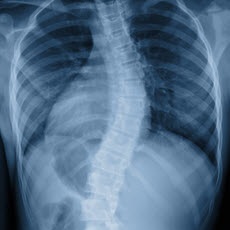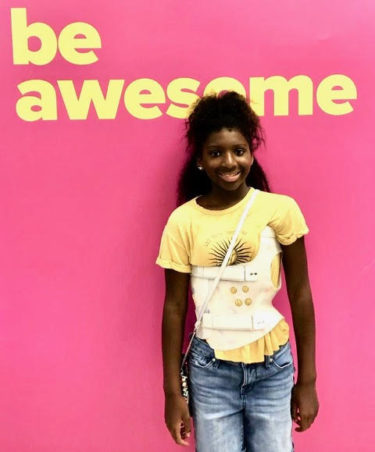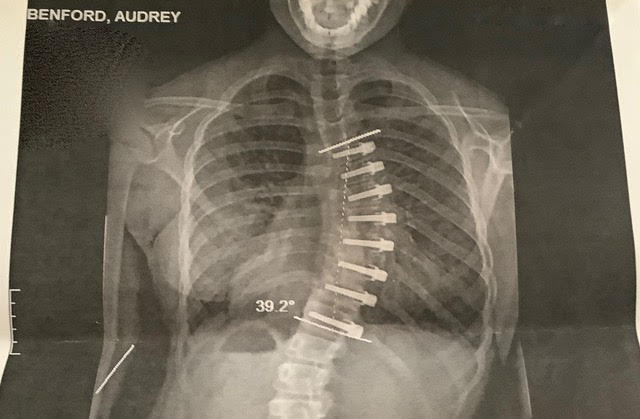By Judi Kanne
Henry County resident Audrey Benford was 10 when she arrived at Children’s Healthcare of Atlanta in December 2018, after her pediatrician diagnosed her with scoliosis.
The news that she would have to wear a back brace to help correct a curvature in her spine was about the last thing this sports-loving pre-teen cheerleader wanted to hear.

Approximately 2 percent to 3 percent of American children have scoliosis or will be diagnosed with it. It’s a medical condition in which a person’s spine has a sideways curve in the shape of an ‘‘S’’ or a ‘‘C.’’ Most children will not suffer harmful long-term effects from the condition, but some will develop serious problems later in life if their scoliosis goes untreated.
Scoliosis is usually detected during routine health exams or as part of a school’s screening program. Adolescents typically are screened for the condition between ages 9 and 16.
Audrey didn’t know it two years ago, but she would eventually become the first pediatric patient in Georgia to undergo Vertebral Body Tethering (VBT), using a new FDA-approved device to correct her condition. In addition, she’s the first patient in the United States to be added to a registry that will track patients over the long term to collect data.
Audrey, when she was asked this week how it feels to be first in the state to undergo the technique, said, “It’s amazing.”
“It only took me a couple of weeks’’ to get back to regular activities after the VBT procedure, she added.
Something beyond a brace
On their first visit to Children’s at Scottish Rite hospital, Audrey and her mother, Flashay Benford, met with an orthopedic surgeon, Dr. Joshua Murphy. He told Benford that Audrey’s curve would get worse if left alone, but that they could begin treating it with a conservative approach, using spinal bracing to stop the problem from progressing.
The downside of this approach is that being in a spinal brace virtually all the time is not fun. Benford said it was a struggle to get her daughter to wear it.

“Audrey hated the brace,” she said. “We would see a change in [her] confidence and self-esteem while she was in it.”
“After six months, we knew it was time to discuss surgical options,” said Benford. Fortunately, those options had increased recently.
Traditional surgery to correct a scoliotic curve is called spinal fusion. Though fairly invasive, it remains the norm. But during one conversation with Audrey and her mother, Murphy mentioned something new: VBT.
It’s not totally new. Though the procedure has been available for approximately a decade, it is still considered innovative, experimental, with no long-term data on the medical outcome for patients who undergo it. In fact, the device that’s used did not receive FDA approval until August 2019, Murphy said.
He described spinal tethering as “a minimally invasive procedure to correct scoliosis in patients who still have growth remaining.”
In Audrey’s case, “we talked about a traditional spinal fusion,” said Benford. “But I never really wanted to go that route because of her age, the loss of mobility and range, and having those rods in her back. It was after a lot of conversations with our family when Dr. Murphy suggested spinal tethering could be an option.”
In just her first seven months after the procedure, Audrey, now 12, experienced a correction of more than 20 degrees in her spinal curve, said her mom.
“Patients can have a shorter recovery time and can return to activity faster,” said Murphy. “We’re approaching this new, innovative technique the right way at Children’s because we’re focused on researching the long-term effects.”
How does VBT work?
In laymen’s terms, the VBT technique uses a series of screws in what are known as the vertebral bodies. The procedure is performed either through four or five small incisions in the chest or with what is known as a “mini-open” procedure.
A polyethylene tape is fed through the anchors and is placed “on tension.” Partial curve correction is achieved at the time of surgery, and the rest comes with continued growth.

Each growth spurt will increase the tension and help to straighten the curvature as the child continues to grow. “In essence, we are utilizing the child’s growth to correct their spinal curve,” said Murphy. With this procedure, patients can maintain flexibility and function in a way they cannot with spinal fusion.
Spinal fusion is still the tried and true surgical method for pediatric patients with scoliosis. Very few patients are ideal candidates for spinal tethering surgery, Murphy said.
“We trusted Dr. Murphy and his dedication to innovate at Children’s — this was definitely the right choice for Audrey,” said Benford.
“Audrey has been very energetic and she’s very positive,” said Murphy. “And I think that’s one of the reasons she’s had such progress. We’ve seen such a great outcome with her so far, and her overall attitude remains very positive.”

From a mom’s perspective, the outlook is equally bright. “Audrey has recovered extremely well,” said Benford. “Just from the surgery there was a noticeable correction.”
Benford said she can look at her daughter and tell the difference from the difficult days. “Now she’s back on the tennis court and swimming and moving.”
Audrey is not only enjoying life these days, but through the registry she’s helping to collect data on the procedure that did so much for her.
Judi Kanne, a registered nurse and freelance writer, combines her nursing and journalism backgrounds to write about public health. She lives in Atlanta.

